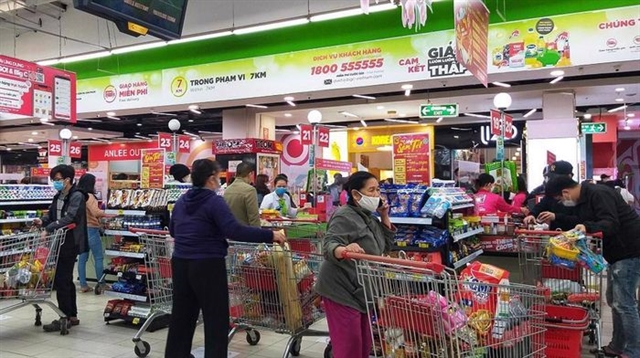 Economy
Economy


|
| In 2022, the national retail sales of goods and services were estimated at VNĐ5.7 quadrillion, up 19.8 per cent over the previous year. — Photo kinhtedothi.vn |
HÀ NỘI — The Ministry of Industry and Trade (MoIT) this year will give priority to developing supply chains of domestic consumer goods and continue to stabilise commodity prices.
Deputy Minister of Industry and Trade Đỗ Thắng Hải said at present, the MoIT is promoting the implementation of solutions to ensure the balance of supply and demand and stabilise the market of essential goods for the Lunar New Year of 2023.
At the same time, it will coordinate with localities to implement market stabilisation programmes to meet people's needs during the peak of the Lunar New Year (Tết).
For the development of the domestic market, Trần Duy Đông, director of MoIT's Domestic Market Department, said that the draft on restructuring the industry and trade industry sets the target to restructure the domestic market towards fast and sustainable development.
In addition, the sector will maintain a seamless connection with import and export markets to ensure the smooth operation of domestic manufacturing activities.
Based on expanding the domestic consumption market, together with the development of Vietnamese brands, the sector will exploit the advantages of the rapid growth of the middle class and young and dynamic consumers.
Accordingly, the ministry will prioritise the development of new consumer economic models such as sharing economy, night-time economy, tourism economy, green economy, circular economy, digital economy, and e-commerce.
It expects that the added value of domestic trade will achieve an average growth rate of about 9-9.5 per cent each year.
In addition, the industry and trade sector will build and develop a synchronous and modern commercial infrastructure system and prioritise modernising the distribution system in rural and mountainous areas. It will encourage enterprises, commercial cooperatives and business households to innovate their operation methods according to modern and professional manners.
Đông said that the ministry has been coordinating with the Ministry of Agriculture and Rural Development to effectively connect production with the market under the supply chain model to ensure stability in supply, demand, price and origin of commodities.
The ministries will manage the quality of goods circulating on the domestic market under international regulations and standards, and implement product and goods traceability. In addition, they also coordinate with localities to develop domestic consumer goods supply chains, especially for agricultural products and food.
Economic expert Vũ Vinh Phú, former chairman of the Hà Nội Supermarket Association, said that to have sustainable development of the domestic market, it is necessary to promote linkages between enterprises and commodity associations in goods consumption, reducing dependence on exports.
Meanwhile, ministries, localities and associations must also link more closely with online fairs and cooperate with e-commerce platforms to promote the consumption of goods.
The MoIT sets a goal that by 2030, goods distributed via the modern retail system will account for about 38-42 per cent, while those sold via e-commerce channels account for about 10.5-11 per cent.
The domestic sector is targeted to account for 85 per cent of Việt Nam's total retail sales of goods. In comparison, the foreign-invested sector will account for about 15 per cent.
According to MoIT, in 2022, Việt Nam controlled the COVID-19 pandemic, so production activities and people's daily life gradually recovered, and the demand for goods increased again.
The domestic supply of goods met the demand, while commodity prices did not have large fluctuations.
Concerning petroleum products, the ministry has carried out many solutions to ensure supply, limiting the impact of fuel price hike.
The ministry reported the prices of many goods on the domestic market tended to increase from the end of the first quarter of 2022.
In the second quarter, the price of input materials rose due to the increase in the price of raw materials on the world market.
However, from the beginning of the third quarter, following the trend of world prices, prices of many commodities have gradually stabilised again.
The General Statistics Office reported that in 2022, the national retail sales of goods and services were estimated at VNĐ5.7 quadrillion, up 19.8 per cent over the previous year. This was a fairly high growth rate in recent years.
After two consecutive years of decline due to the impact of COVID-19, the country's total retail sales this year rebounded sharply. That meant the State's post-pandemic economic recovery policies have been effective, and people's purchasing power has gradually restored to the pre-pandemic level. — VNS




